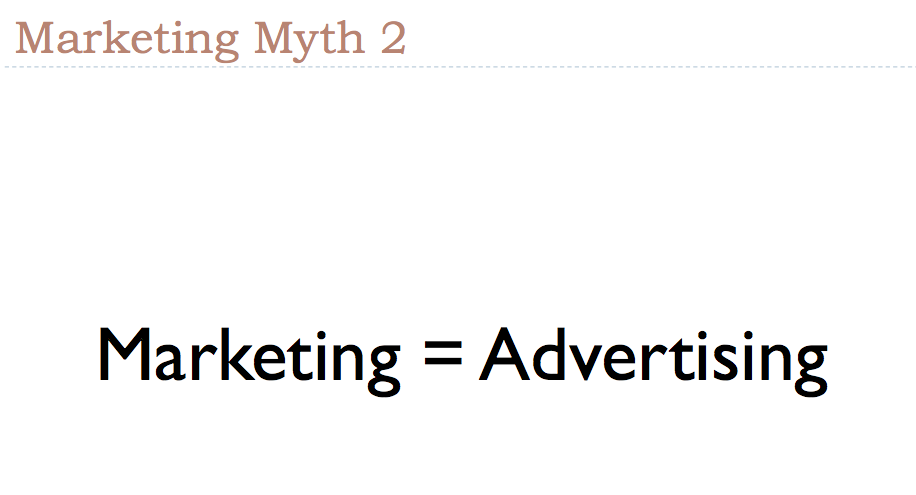We were deeply honored (and tinkled pink) that our very own Shari Worthington was invited to speak at the inaugural TEDx event at WPI on April 6, 2014. We’ll post the link to the talk as soon as it’s available. In the meantime, here is the material from Shari’s talk on “Psychology, Neuroscience, and Behavioral Economics: Why Most People Don’t Get Marketing.”
TED Talks are designed to get people around the world thinking in new ways, talking, discussing, debating! We look forward to your comments.
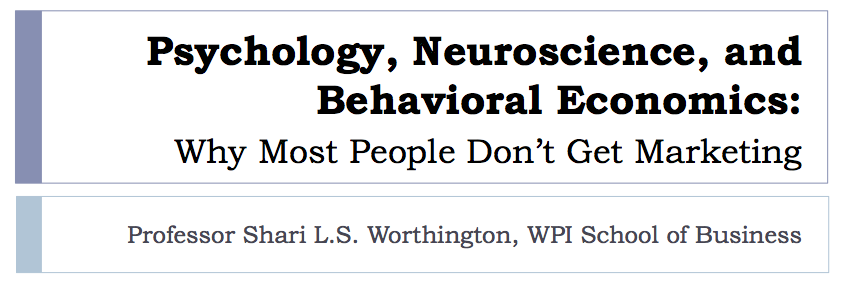
Let me take you back in time. You just got your first job and you excitedly tell your parents, I’m a babysitter, or I’ve got a newspaper route, or I’m packing groceries at Acme. Everyone’s happy and you’ve taken your first steps to personal and financial independence.
Fast forward a couple of years. You graduate and land the job that you are sure is going to be your career. You tell your family. In my case it went like this.
Guess what? I found the perfect job. I’m so excited.
Great, they say, what is it?
Marketing, What? Marketing. You know, understanding customers and launching new products. Oh, you mean sales. No, marketing. You know, writing press releases and creating ads. Oh, you mean that weird subliminal advertising stuff.
Sigh. I realized early on in my marketing career that marketing has a marketing problem.
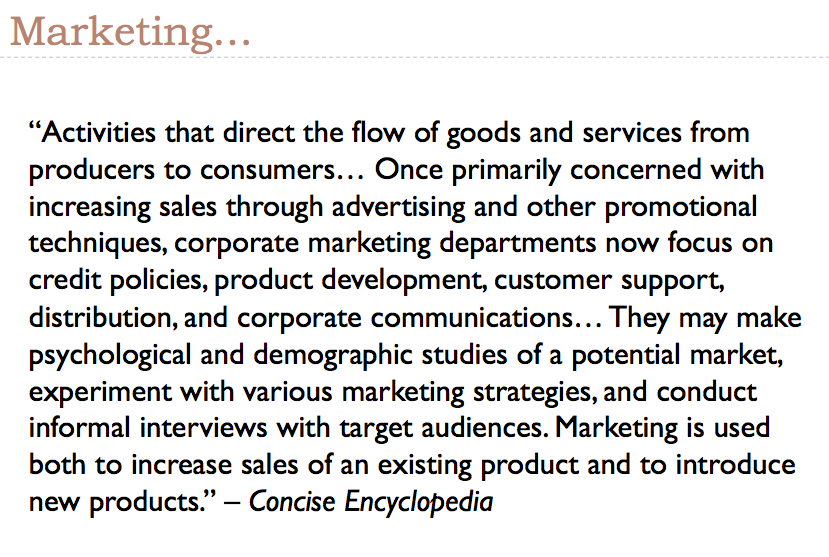
So I decided to do some research on an all-inclusive response to what is marketing? Here is a typical example of what I found
A little wordy, maybe? How many of you did I lose half-way through? Lol
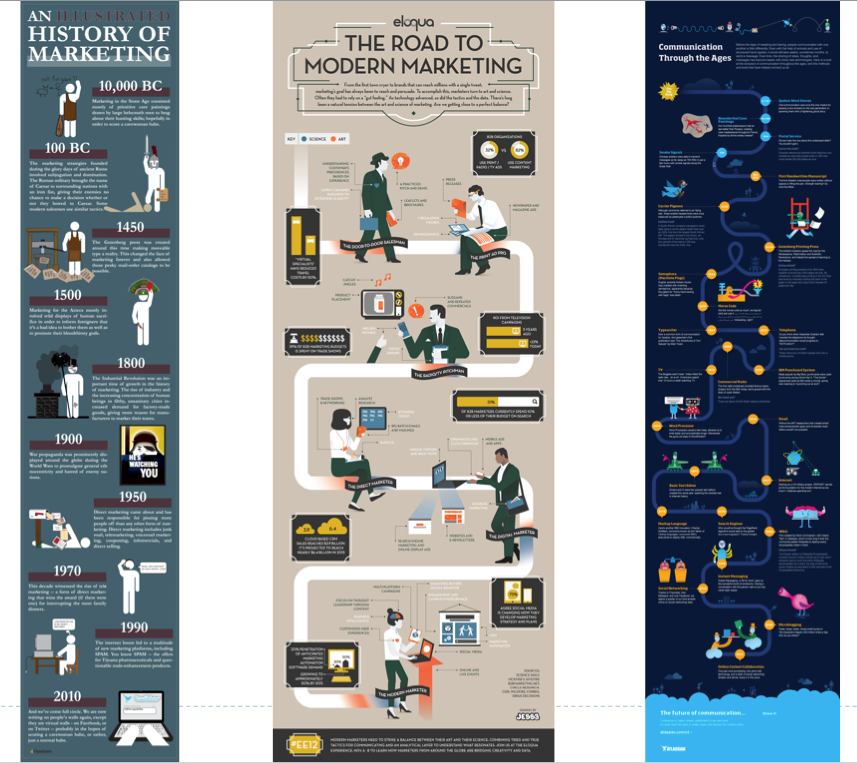
So I decided to try something more visual. I love infographics. A way to tell a story with text and data and graphics.
I found An Illustrated History of Marketing: from cavemen carving on walls to human sacrifice of the Aztecs (yikes!) to the printing press
Then I found The Road to Modern Marketing: from the Fuller brush salesman to David Ogilvy, the print ad pro, to television to direct mail to online marketing
Then I found this really cool infographic, Communication Through the Ages: smoke signals, morse code, typewriters, telephones, radio, TV, word processors
You get the drift. But still not the elevator pitch we marketers need.
On a side note: my pet peeve is data floating around the Internet without a source. Sadly, this happens a lot, especially with infographics. But the world doesn’t need yet more random data asserted as research. So let’s work with facts today.
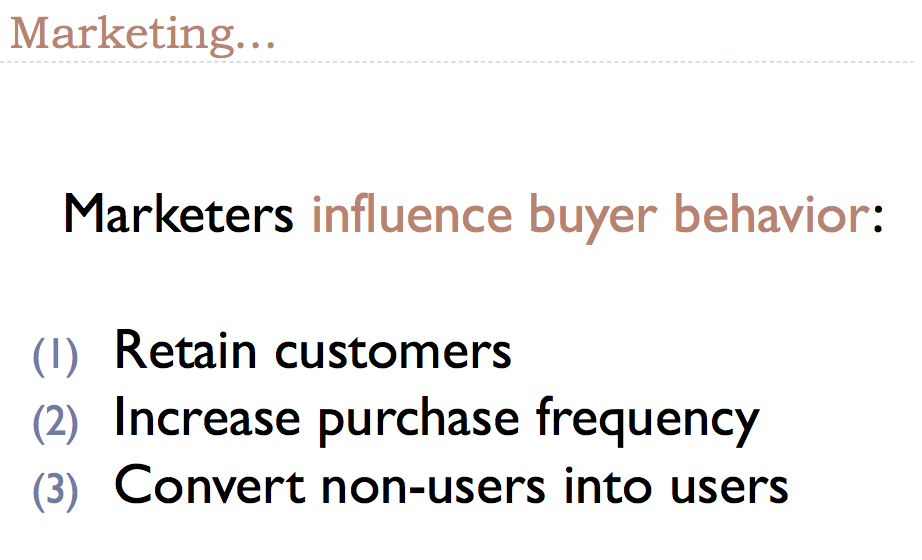
Here’s a nice, concise summary. Something that everyone can grasp because, quite frankly, EVERYONE NEEDS TO BE MARKETING.
Daniel Pink, in his book To Sell is Human, put forward a darn good case for EVERYONE IS SELLING whether impressing the boss at work or convincing your spouse to go on that cruise.
But before you can be selling, you need to be marketing. You need to understand who you’re trying to influence, what they care about and, therefore, are willing to invest in (whether it’s time or money), how much they’re willing to invest, and how to best deliver your convincing message.
For instance, where do you want to make your next career move? Which industries offer the best possibilities? Which can benefit from your skills?
The new local pizza joint needs to decide if they are better off selling to the college students a block away OR to the elders in the housing unit on the other side of the street.
So let’s dispel a few marketing myths as we help marketing do marketing.
First, marketing is NOT sales.
Marketing is about understanding groups of customers with common characteristics. We factor in industry trends to determine which products are right for these customers we’re targeting.
Sales is all about interacting with individual customers and closing the deal.
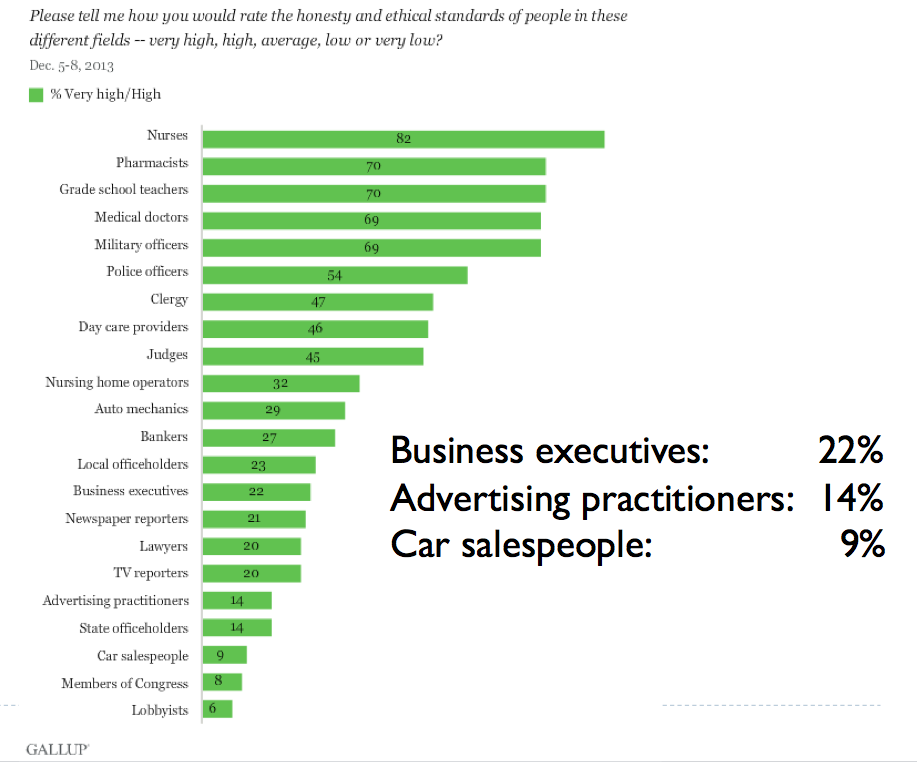
Marketing and selling are both built on trust. Who do our customers trust? In the latest Gallup survey, we business people have a credibility problem. We may be experts in particular technologies and processes, but we are facing big trust issues.
In the survey, nurses ranked at the top of the trust hierarchy with 82%. These were followed by pharmacists, teachers, medical doctors, and military officers at 69-70%.
We have to move way down the scale to find Business Executives at 22%, Advertising Professionals at 14%, and Car Salespeople at 9%. Based on all the lawyer jokes, you’d think they’d be at the bottom, but no they’re above advertisers at 20%.
Hoo boy marketing really has a branding problem!
Marketing is NOT all advertising.
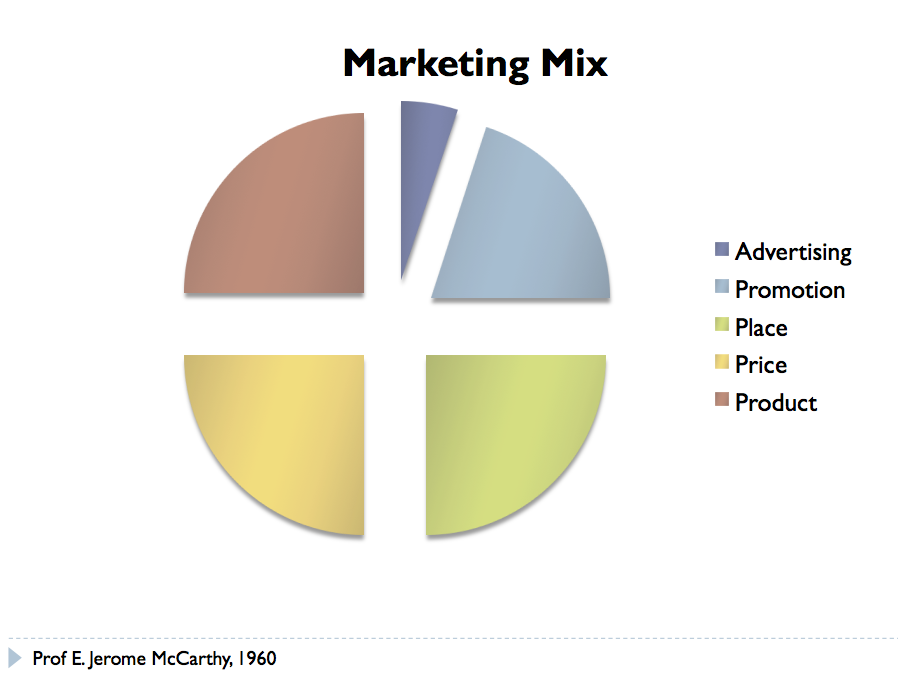
Marketing helps the sales team sell the right product to the right customer at the right price through channels that are convenient to the customer.
That’s the 4 P’s: Product, Price, Place, Promotion.
Advertising is a small portion of what marketers do. In fact, it’s an increasingly smaller portion thanks to the Internet and new behaviors like banner blindness.
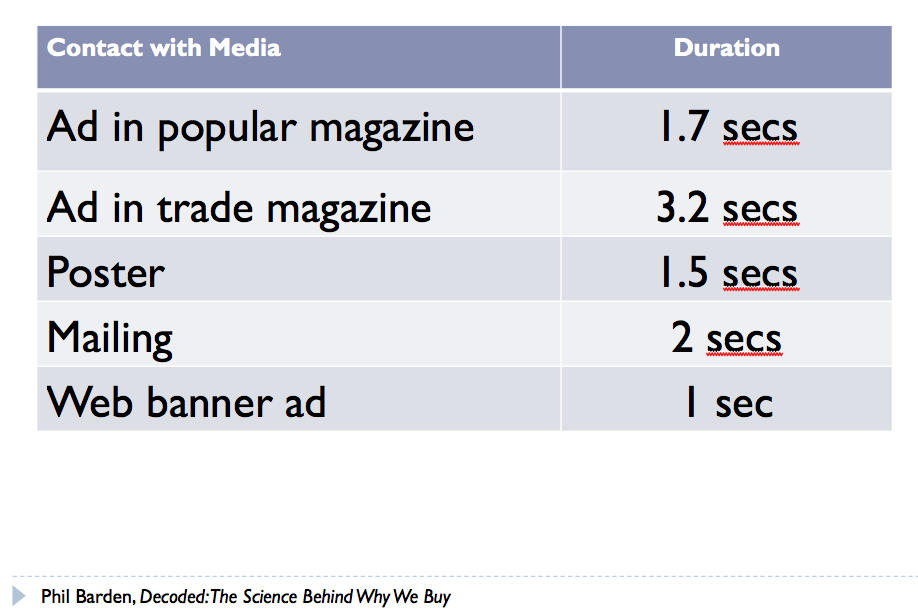
Our sophisticated mental apparatus has allowed us to improve life. But we have created an environment so complex, fast-paced, and info-laden that we increasingly need short-cuts to deal with it.
Let’s start with this data how much time do we spend interacting with advertisements
Most marketers rely on an outdated model of buyer decision-making: EMOTIONAL vs RATIONAL. How much logic or emotion can you get out of a 1.5 second interaction with anything?
Let’s look at the NEUROSCIENCE. Our senses are bombarded with 11 MILLION BITS of INFO EVERY SECOND. 11 million!!! But the upper limit of our working memory is 5-9 chunks of info, which translates to 40-50 bits. That leaves 10,999,950 bits of info that need to be processed. So we need short-cuts that will help us save time, energy, and mental capacity.
Enter the Nobel Prize-winning work of Daniel Kahneman. He studied decision-making behavior and introduced the AUTO-PILOT / PILOT framework.
Our AUTO-PILOT integrates perception and intuition. It’s always running. It’s made for fast, automatic, intuitive actions without thinking.
The PILOT uses reflective thinking to make decisions, which requires energy. So, in a way, our brain is not made for thinking, not when we have such massive amounts of information to deal with.
COGNITIVE PSYCHOLOGY: When we learn something new for the first time, the PILOT is engaged. We stop and think and learn. With repetition and experience, we develop intuition and the processes become automated and more efficient. Malcolm Gladwell, author of The Tipping Point, says it takes 10,000 hours of practice to make an action automatic.
Once we have sufficient experience under our belts and have developed our intuition, the PILOT system only comes into play when we face new problems.
A strong BRAND activates the AUTO-PILOT and circumvents PILOT processing. Weak brands, by contrast, active the PILOT, making buyers stop and think about the purchase decision. Now you are likely to lose them.
Between the AUTO-PILOT and the overwhelming info flow across the Internet, we now have to deal with situations like this: 40-70% of all purchase decisions are made at the Point of Sale with little to no pre-planning. From a communications perspective, the messaging has to be sufficiently new for learning to occur.
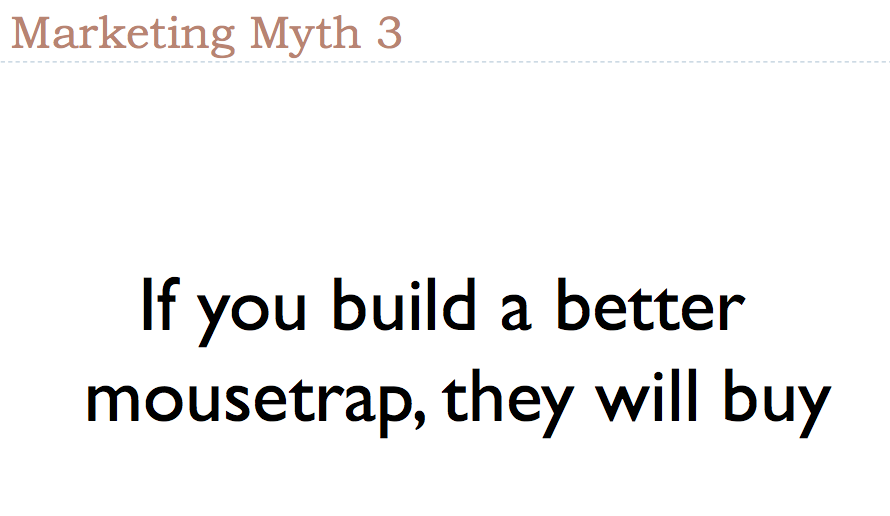
I’ve spent most of my career in technology marketing. That’s an engineering driven world that firmly believes the better product will win. That may have worked decades ago when the pace of tech advances was much slower. Today, Forbes says we’re seeing at least 250,000 products launched per year globally, with an average failure rate of 85-95%.
And being first in a product category often doesn’t help. Was Amazon the first online bookseller? Nope books.com. Was Apple’s iPod the first MP3 player? Nope. The first was launched in 1997 by Saehan Information Systems in Asia. The first player widely available in the US was from Diamond Multimedia in 1998. Was iTunes the first digital music? Nope. That goes to Napster in 1999, which was sued by the music industry and closed in 2001.
So what leads to success?
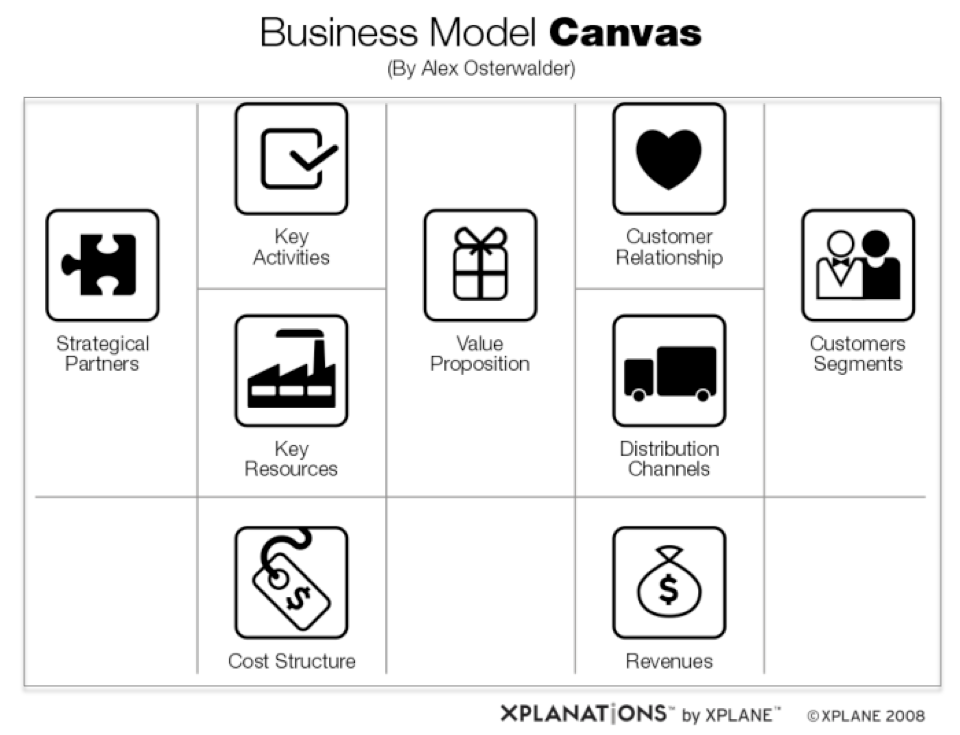
It takes a good product and a great business model. No marketer worth their salt works without a business model that focuses on a unique combination of target customer segments, value propositions (what’s in it for the customer), and key resources and partnerships.
In fact, what made the iPod / iTunes combination a success was the PARTNERS portion of its business model. This was a result of the deal-making of the one and only Steve Jobs. In 2001, the music industry had just taken Napster down and they thought they were infallible. Jobs walked in and showed them the demand was there for digital music. They had to find a way to embrace the technology and he had the answer they needed. Who else but Jobs could sway them. And sway them he did.
Since iTunes launched, $33 billion has been paid to content owners, $9 billion in 2012 alone. What started as a music system is now music, apps, software, books, and videos.
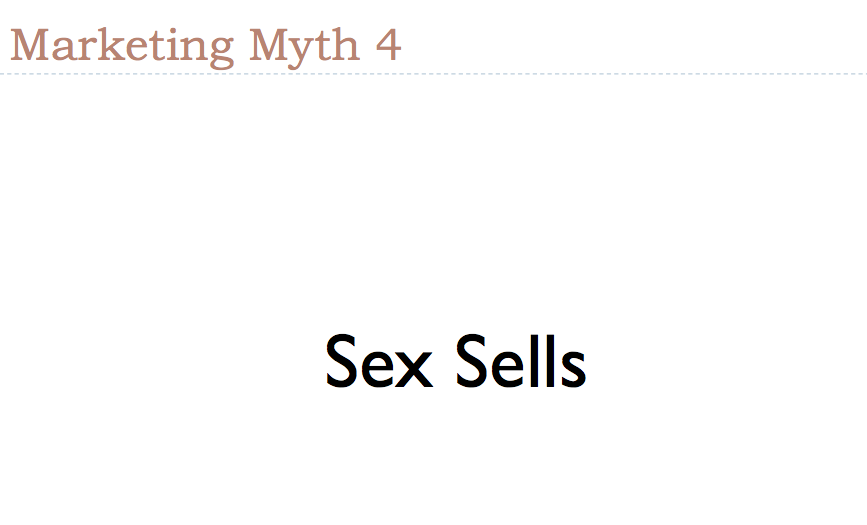
The idea of commercial advertising is pretty simple: people see, listen to, or read an advertisement. They recall the brand, its tag line, and the product. They later recognize the products in stores or on the web, and buy it. They trust products more that have been advertised. The problem is how do we get the ad noticed and remembered in the first place?
Ad agencies use drama, humor, sex, and violence to make the ads more attention grabbing, interesting, and memorable. They try to elicit emotions that enhance memory.
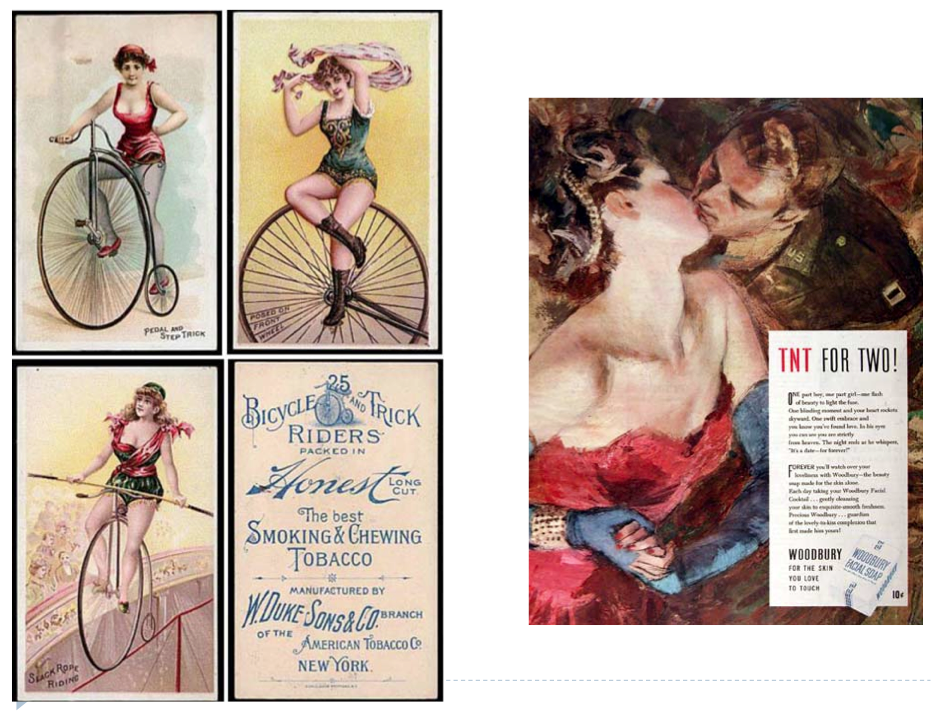
These ads are from the late 1800’s and early 1900’s. They were considered scandalous at the time, given the amount of skin that was shown. But do ads that focus on a sexual theme actually sell products?
Research by Bushman and Furnham looked at recall when ads were placed with violent or sex TV programs. The studies showed that those watching the neutral program remembered the most. Irrespective of their sex or age or how much they liked the program, the sex and violent programs seemed to impair memory for the advertised products.
But sexing up an ad and putting it in a non-sexy program might just work. You can get a strong ISOLATION EFFECT, which means the ad stands out like a sore thumb. Unfortunately, that effect is consistently reduced every time the ad is shown. It’s a paradox: the more you see a sexy ad, the less of an effect it has.
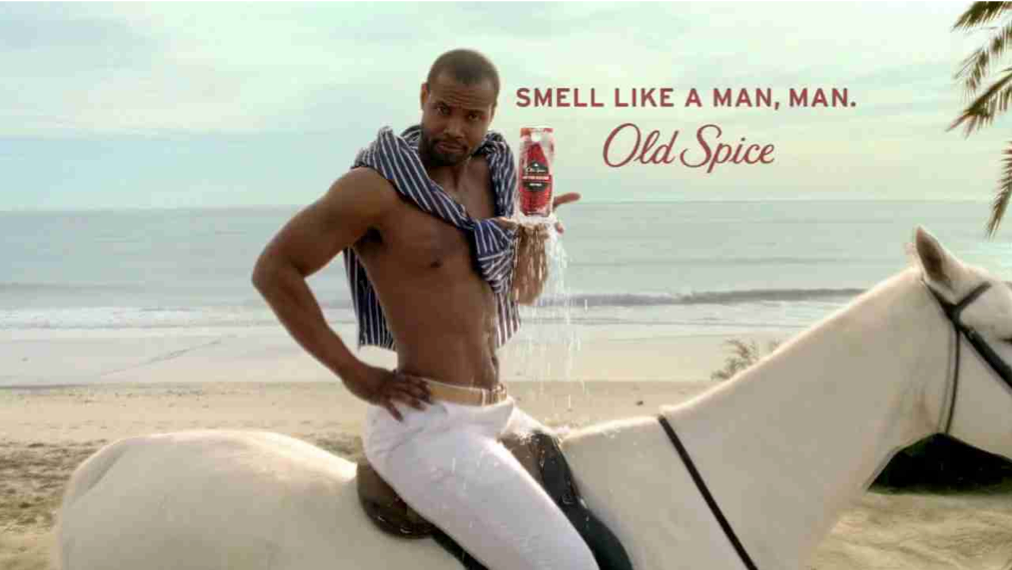
Professor Tom Reichert has spent a long time researching the history of sexual images. His studies show that sex is primarily used to sell low-risk products purchased on impulse – alcohol, entertainment, and beauty products.
Sex is not as effective when selling high-risk, informational products such as banking services, appliances, and automation equipment.
Let’s take a look at the Old Spice campaign that launched in 2010 centered around the theme The Man Your Man Could Smell Like. It captured the imagination of the public. The original ad has garnered more than 48 million views to date on YouTube.
In 2011, they kicked it up a notch with the Old Spice “Responses” campaign, during which a team of marketers pumped out more than 180 personalized videos featuring “The Old Spice Guy” responding to questions posed by fans. This campaign increased sales, generated over 24 million views on Youtube, and took home a Creative Emmy Award for Best Commercial of the Year.
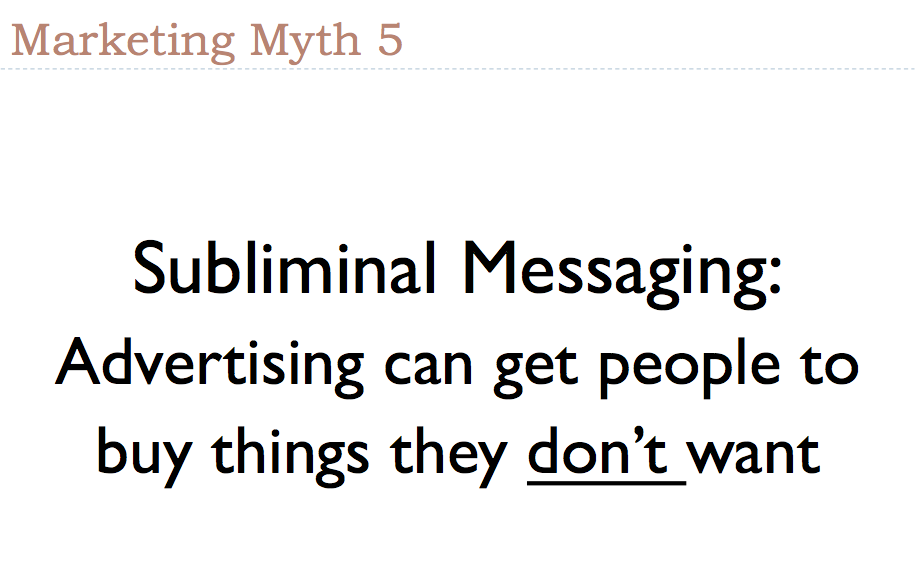
The first person to coin the term was James Vicary, a market researcher. In 1957, He stated that he inserted messages into a movie in New Jersey. The messages, which flashed for 1/3000th of a second, told moviegoers to drink Coca-Cola and eat popcorn.
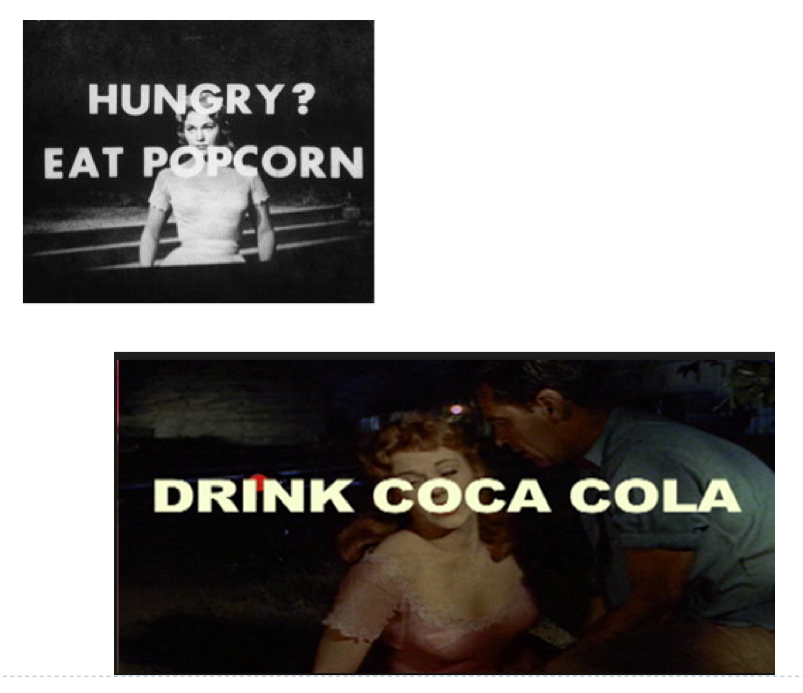
According to Vicary, Coke sales in the theater increased by more than 18% and popcorn sales by more than 57%.
Turns out, he actually lied about the results of his study. He also appeared to have lied about whether the study took place. The owner of the movie theatre said it never happened.
What came out of Vicary’s exercise is that subliminal messages could affect people’s conscious thoughts and actions. This spread like wildfire. In 1958, the National Association of Broadcasters banned subliminal ads. And federal legislation was proposed several times, but never went anywhere.
Here we are over 50 years later and articles are still being written about the evils of subliminal advertising. Law web sites, Salon magazine, New York Times columns .
The reality is that people cannot be manipulated at will. If something is not compatible with our conscious or subconscious goals – at that moment and in that context – then we won’t do it. In fact, we won’t even perceive it.
Let’s look at BEHAVIORAL ECONOMICS. When it comes to decision-making, our brain calculates a NET VALUE between reward and pain. If reward exceeds pain, buyer will purchase. Prices, by the way, activate the PAIN area in the brain. What do you think sex activates? J
The AUTO-PILOT’s decision-making process is based on VALUE and COSTS. This system is also sensitive to peripheral signals, expectations, habits, heuristics (auto decision rules), and the context in which the decision is made.
We have rules:
The higher the quality, the higher the price
The more often we use something, the more we value it
Flowery titles activate value expectations, e.g. tender, Kobe beef vs steak
Hyperbolic discounting: the further away something is in time, the less value we assign it

In doing research on subliminal advertising, this ad came up as an example. BK’s Super Seven Incher. Sexy red lipstick on the open mouth of the model. Surprised look. It’ll blow your mind away.
Is there anything subliminal here? Nope. This goes right back to the SEX SELLS portion of our discussion.
The bottom line is we all need to market throughout our life and career. To do this effectively, we need to understand the data and behavior involved in:
Business strategy
Psychology
Neuroscience
Behavioral Economics
HAVE FUN! Thank you.


